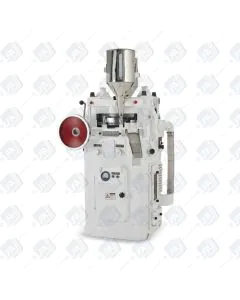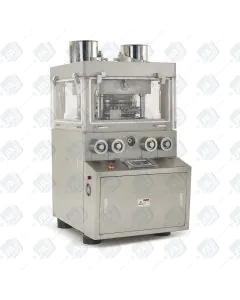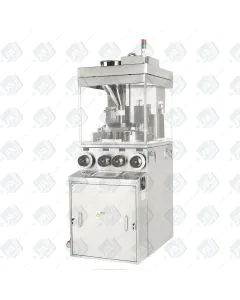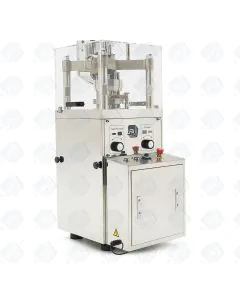Multiple Station Tablet Rotary Press
There are 2 types of tablet presses: single-punch and rotary tablet presses. Most high speed tablet presses take the form of a rotating turret that holds any number of punches and dies. As they rotate around the turret, the punches come into contact with cams which control the vertical position of each punch. Tablets produced by a rotary tablet press are compressed into uniform size, shape and weight making it the preferred machine for large-scale manufacture as it also produces more tablets than single punch machines.
Punches and dies for rotary tablet presses are usually custom-made for each application, and can be made in a wide variety of sizes, shapes. They can be customized with manufacturer codes and scoring lines to make tablets easier to break. Depending on tablet size, shape, material, and press configuration, a typical modern press can produce from 250,000 to over 1,000,000 tablets an hour.

Basic components of the Tablet Rotary Punch Machine
- Hopper – holds the material that are to be compressed, sends the material to the die and removes the tablet after compression.
- Head – the machine head holds the dies, and the upper and lower punches. It is the head of the machine that rotates.
- Upper and lower turrets – parts of the machine’s head that hold the upper and lower punches
- Die table – part that holds the dies.
- Die table – the section of the turret that holds the dies.
- Cam track – as the head rotates, the punches moves up and down guided by the fixed cam track. The cam track controls the powder filling and compression as well as the ejection of completed tablets.
- Dies – these determines the size and shape of the tablets by acting as a mould for the upper and lower punches as they come close together on compression.
- Lower and upper punches – used to compress the materials inside the die.
- Capacity regulator/weight control unit – it allows the repositioning of the lower punch to accommodate the required quantity of powder for each fill.
- Ejection regulator – it allows the lower punch to be adjusted so that the top surface of a lower punch is at the same height as the surface of the die.
- Driving wheel – helps in manually setting the movement of the upper and lower punches and hopper shoe.
Zapisz się do naszego newslettera
Rotary Tableting machine Tooling
The size, shape and the identification marks of the tablet are determined by the compression machine tooling, i.e., the punches and dies. The tooling must meet the specific requirements to satisfy the needs of dosage uniformity, production efficiency and aesthetic appearance. Internationally there are two recognized standards for tablet compression tooling: the TSM standard and the EU standard. TSM is acronym for the ‘Tablet Specification Manual’, widely recognized and exclusively used in the United States. The EU or ‘European Standard’ is probably more widely used than the TSM standard.
Based on the TSM and EU standards, tablet tooling is mainly classified as B tooling and D tooling. The B tooling punches and dies can be further classified as BB, and D tooling can also be used on B tooling machine that is call as DB. The dimensions of these standard tools are given in the table below.
| Type of Tooling | Punch Dia. (mm) | Die Dia. (mm) | Punch Length (mm) | Max Size Round/Capsule |
|---|---|---|---|---|
| B tooling | 19 | 30.16 | 133.60 | 16/19 |
| D tooling | 25.4 | 38.1 | 133.60 | 25/25 |
| BB tooling | 19 | 24 | 133.60 | 13/14 |
| DB tooling | 25.4 | 30.16 | 133.60 | 19/19 |

Procedure for the operation of a rotary tablet press
- The upper and lower punches as well as the die in should be located and fixed in the rotary pill press machine.
- The feed frame along with the hopper should be set up and the weight control unit adjusted for the require weight and hardness of the tablets.
- The hopper is next filled with the tablet powder mix or the granulated formula.
- On starting the machine, the powder mix will be delivered by the hopper to the feed frame which feeds it into the area where the dies are located.
- The feed frame will confine the mix and position it over the die track.
- As the head revolves, the dies are located one by one under the feed frame where they are filled.
- Materials are then compressed by the upper and lower punches into the dies sequentially.
Advantages of Tablet Machines
- The machine is effectively a multiple station unit affording more rapid production than a single tablet press.
- There is independent control of weight and hardness of tablets by the weight control unit
- There is less trial and error involved compared with manual operation
- The machine can be fine tuned to meet all specifications
- Reduced powder wastage
- Tablet pressure is controlled through a lever
- Filling the powder is done automatically
- Machines are supplied without punches or dies which have to be ordered according to the desired product.
- Significant high output of 9000 up to 500,000 tablets/hour leading to increased production efficiency, money and saving in process time.
Models of LFA Rotary Tableting Machines
Single Rotary Press
- Suitable for “D” , “B” and “BB” tooling
- Safety interlocking for the lower and upper guard
- 2-piece turret, turret with lower punch seal
- Gravity feeding system
- Upper Roller with Reflection Adjustment System
- Control Panel With Bypass Switches
- Control Panel with Separate display for TABLET COUNT and RPM
- Fixed Hopper with slide to control power flow
- Hand Wheel Provided
- Variable speed pulley
- Cam tracks & pressure rolls made out of alloy steel for maximum wear resistance and long life. Worm gear is made up of Phosphor Bronze.
- Machine is totally enclosed, i.e., top half of the machine (Compression zone) with SS hood, acrylic covers in the GMP model (this reduces the noise level between compression and machine room).
- Phosphor bronze bush provided inside the turret hold
- SS Turret Guards
- Lower Punch Cam can be easily removed without dismantling the Lower Roller Assembly
The LFA HSTP (High-Speed Tablet Press) – the newest machine with high production output, excellent tablet quality, accurate tablet weight, waste reduction capacity, compliant with GMP standard. Electronic controls are separate from the main machine.
- Applications – chemical, electronic, cosmetic, food and pharmaceutical
- Machine is designed for various granular materials and products (i.e., round tablets, annular, geometric shaped tablets)
- Can impress characters or symbols on both sides, using customized punches and die set
The LFA RTP 41 (41 Station Rotary Tablet Press) – machine used in food and pharmaceutical companies to produce round and irregular shaped tablets.
- Meets the GMP standard
- Pressing chamber is separate from the drive system, paint-free
- All parts are made of stainless steel, surface treated (especially parts that come in contact with the powder and tablet)
- Sealed chamber to prevent contamination
- Gear system, wearing parts, guides are fully lubricated
- Equipped with special feeding device to ensure accurate feeding especially for specialty powders
- Easy to observe and adjust thickness, pressure, feeding and speed via hand control.
- Operational indicators are located in the same area/side.
The LFA RTP 33 (33 Station Rotary Pellet Press) – fully automatic, double press type. Outside part is fully enclosed, stainless steel material for cover and inside table.
- Drive speed is adjustable
- Drives are enclosed for cleanliness and prevention of contamination
- Smooth and stable operation due to use of a hydraulic system
- Overload protection to prevent damage – machine automatically stops
- Turret carries 33 sets of punches and dies, 66 tablets are pressed per revolution
- Adjustable turret rotation speed, filling material depth, tablet thickness











